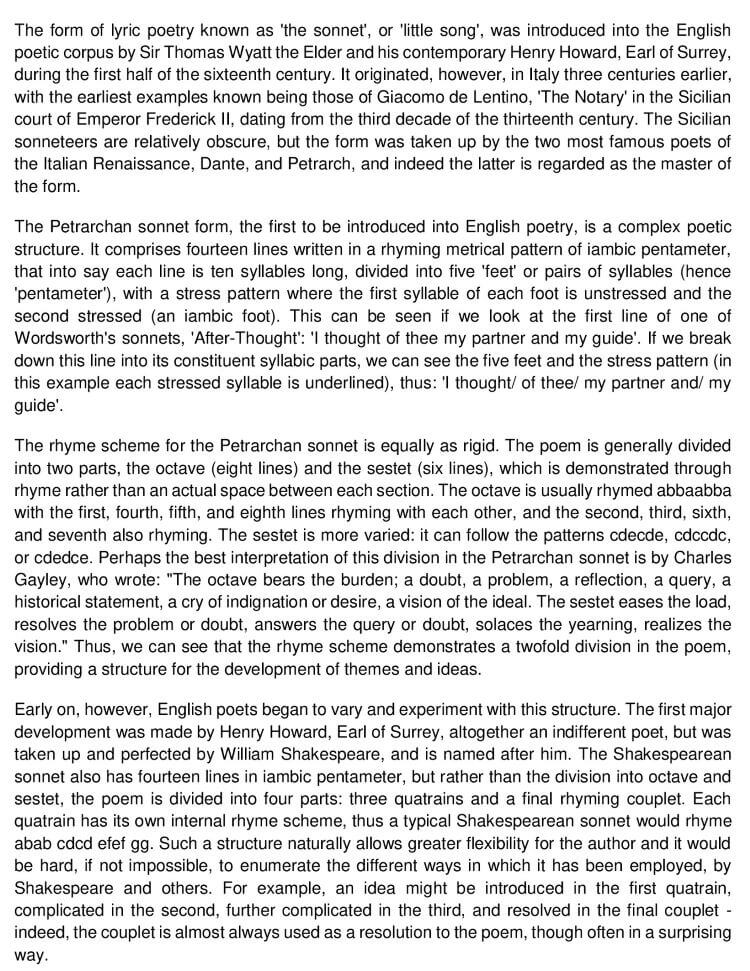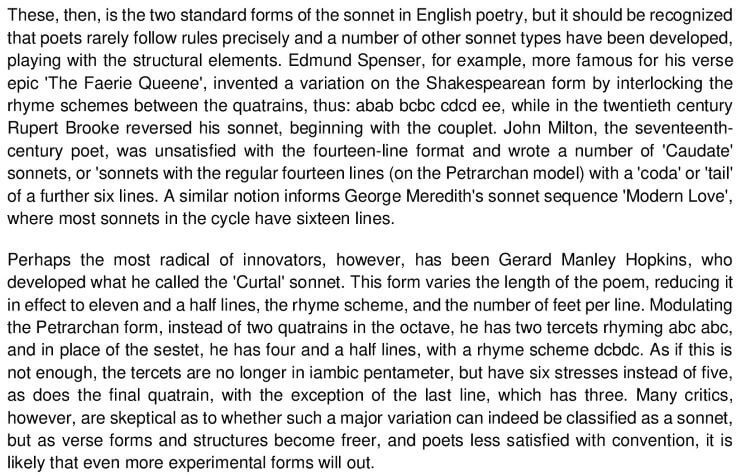Variations on a Theme: the Sonnet Form in English Poetry - IELTS Reading Answers
9 min read
Updated On
-
Copy link
You will find IELTS Academic Reading passage, Variations on a Theme: the Sonnet Form in English Poetry Reading Answers, in this article. Practise this one and you will get an idea of how to deal with IELTS Reading.
Table of Contents

5 Most Recent IELTS Reading Practice Tests
Various question types are asked in IELTS Academic Reading to test specific reading skills and some of them are given in Variations on a Theme: the Sonnet Form in English Poetry IELTS Reading Answers. These question types are:
- IELTS Reading Matching Headings (Q. 28-32)
- IELTS Reading Sentence Completion (Q. 33-37)
- IELTS Reading Multiple-Choice Questions (Q. 38-40)
Ideally, IELTS test-takers should take around 20 minutes to solve a passage like ‘Variations on a Theme: the Sonnet Form in English Poetry’ in IELTS Academic Reading. Therefore, to master this skill, they need to take IELTS reading practice tests regularly. Let’s see how easy this passage is for you and if you’re able to make it in 20 minutes.
Reading Passage
Variations on a theme: the sonnet form in English poetry


Questions 28-32
Reading Passage has eight paragraphs labeled A-H.
Choose the most suitable heading for each paragraph from the list of headings below.
Write the appropriate numbers (i-xiii) in boxes 28-32 on your answer sheet.
Note: There are more headings than paragraphs, so you will not use all of them.
| List of Headings
i. Octave develops sestet ii. The Faerie Queene and Modern Love iii. The origins of the sonnet iv. The Shakespearean sonnet form v. The structure of the Petrarchan sonnet form vi. A real sonnet? vii. Rhyme scheme provides structure developing themes and ideas viii. Dissatisfaction with format xi. The Sicilian sonneteers x. Howard v. Shakespeare xi. Wordsworth’s sonnet form xii. Future breaks with convention xiii. The sonnet form: variations and additions |
28 Paragraph A
29 Paragraph B
30 Paragraph C
31 Paragraph D
32 Paragraph E
Questions 33-37
33 Sir Thomas Wyatt the Elder and Henry Howard were …………………………………. .
34 It was in the third decade of the thirteenth century that the …………………………………. was introduced.
35 Among poets of the Italian Renaissance …………………………………. was considered to be the better sonneteer.
36 The Petrarchan sonnet form consists of …………………………………. .
37 In comparison with the octave, the rhyming scheme of the sestet is …………………………………. varied.
Questions 38-40
38 According to Charles Gayley,
A the octave is longer than the sestet.
B the octave develops themes and ideas.
C the sestet provides answers and solutions.
D the sestet demonstrates a twofold division.
39 The Shakespearean sonnet is
A An indifferent development.
B more developed than the Petrarchan sonnet.
C more flexible than the Petrarchan sonnet.
D enumerated in different ways.
40 According to the passage, whose sonnet types are similar?
A Spenser and Brooke
B Brooke and Milton
C Hopkins and Spencer
D Milton and Meredith
Answer for Variations on a Theme: the Sonnet Form in English Poetry IELTS Reading Answers with Location and Explanations
Check out the answer key for this IELTS Reading passage, Variations on a Theme: the Sonnet Form in English Poetry, with detailed explanations.
28 Answer: iii
Question type: Match the headings
Answer location: Paragraph A, lines 1-6
Answer explanation: “The form of lyric poetry known as ‘the sonnet’, or ‘little song’, was introduced into the English poetic corpus by Sir Thomas Wyatt the Elder and his contemporary Henry Howard, Earl of Surrey, during the first half of the sixteenth century. It originated, however, in Italy three centuries earlier, with the earliest examples known being those of Giacomo de Lentino, ‘The Notary’ in the Sicilian court of Emperor Frederick II, dating from the third decade of the thirteenth century.” Thus, through the given lines, it can be easily understood that the paragraph talks about the origin of Sonnets and how they came into the picture.
29 Answer: v
Question type: Match the headings
Answer location: Paragraph B, lines 1-5
Answer explanation: “The Petrarchan sonnet form, the first to be introduced into English poetry, is a complex poetic structure. It comprises fourteen lines written in a rhyming metrical pattern of iambic pentameter, that into saying each line is ten syllables long, divided into five ‘feet’ or pairs of syllables (hence ‘pentameter’), with a stress pattern where the first syllable of each foot is unstressed and the second stressed (an iambic foot).” This clearly suggests what the structure of the Petrarchan sonnet is. Therefore, the answer would be option v
30 Answer: vii
Question type: Match the headings
Answer location: Paragraph C, lines 7-11
Answer explanation: “The octave bears the burden; a doubt, a problem,. a reflection, a query, a historical statement, a cry of indignation or desire, a vision of the ideal. The sestet eases the load, resolves the problem or doubt, answers the query or doubt, solaces the yearning, realizes the vision.” Thus, we can see that the rhyme scheme demonstrates a twofold division in the poem, providing a structure for the development of themes and ideas.’” This clearly depicts the role of rhyme scheme in the development of ideas and themes.
31 Answer: iv
Question type: Match the headings
Answer location: Paragraph D, lines 1-6
Answer explanation: “The first major development was made by Henry Howard, Earl of Surrey, altogether an indifferent poet, but was taken up and perfected by William Shakespeare, and is named after him. The Shakespearean sonnet also has fourteen lines in iambic pentameter, but rather than the division into octave and sestet, the poem is divided into four parts: three quatrains and a final rhyming couplet.” This entire paragraph and especially, the lines that quote, talk about Shakespeare’s style of Sonnet and hence the heading should be related to Shakespeare, as he is the central idea of the paragraph and the lines.
32 Answer: xiii
Question type: Match the headings
Answer location: Paragraph E, lines 3-9
Answer explanation: “Edmund Spenser, for example, more famous for his verse epic ‘The Faerie Queene’, invented a variation on the Shakespearean form by interlocking the rhyme schemes between the quatrains, thus: abab bcbc cdcd ee, while in the twentieth century Rupert Brooke reversed his sonnet, beginning with the couplet. John Milton, the seventeenth-century poet, was unsatisfied with the fourteen-line format and wrote a number of ‘Caudate’ sonnets, or ‘sonnets with the regular fourteen lines (on the Petrarchan model) with a ‘coda’ or ‘tail’ of a further six lines.” This makes the idea of variations and diversity in the style and format of sonnets apparent. Hence the option, The sonnet form: variations and additions, is right.
33 Answer: CONTEMPORARIES
Question type: Sentence completion
Answer location: Paragraph A, lines 1-3
Answer explanation: “The form of lyric poetry known as ‘the sonnet’, or ‘little song’, was introduced into the English poetic corpus by Sir Thomas Wyatt the Elder and his contemporary Henry Howard, Earl of Surrey, during the first half of the sixteenth century.” This clearly suggests that Sir Thomas Wyatt the Elder and Henry Howard were contemporaries.
34 Answer: SONNET / LITTLE SONG
Question type: Sentence completion
Answer location: Paragraph A, lines 3-6
Answer explanation: “It originated, however, in Italy three centuries earlier, with the earliest examples known being those of Giacomo de Lentino, ‘The Notary’ in the Sicilian court of Emperor Frederick II, dating from the third decade of the thirteenth century.” This clearly suggests that ‘it’, i.e.The Sonnet was introduced in the third decade of the thirteenth century.
35 Answer: PETRARCH
Question type: Sentence completion
Answer location: Paragraph A, lines 6-8
Answer explanation: “The Sicilian sonneteers are relatively obscure, but the form was taken up by the two most famous poets of the Italian Renaissance, Dante and Petrarch, and indeed the latter is regarded as the master of the form.” This line makes it quite clear that Petrarch was the best sonneteer and is considered the master of the form.
36 Answer: FOURTEEN LINES/ OCTAVE AND SESTET
Question type: Sentence completion
Answer location: Paragraph B, lines 1-5/ Paragraph C, lines 1-3
Answer explanation: “The Petrarchan sonnet form, the first to be introduced into English poetry, is a complex poetic structure. It comprises fourteen lines written in a rhyming metrical pattern of iambic pentameter, that into saying each line is ten syllables long, divided into five ‘feet’ or pairs of syllables (hence ‘pentameter’), with a stress pattern where the first syllable of each foot is unstressed and the second stressed (an iambic foot).” This line suggests that the Petrarch Sonnet comprised 14 lines that were written in a rhyming pattern. While the lines “The rhyme scheme for the Petrarchan sonnet is equally as rigid. The poem is generally divided into two parts, the octave (eight lines) and the sestet (six lines), which is demonstrated through rhyme rather than an actual space between each section.” this suggests that the Petrarch sonnet was divided into Octaves and Sestets. Hence the answer could be either Fourteen lines or Octaves and Sestets.
37 Answer: MORE VARIED
Question type: Sentence completion
Answer location: Paragraph C, lines 5-6
Answer explanation: “The sestet is more varied: it can follow the patterns cdecde, cdccdc, or cdedce.” This clearly suggests that the sestets are more varied than the octaves.
38 Answer: C
Question type: Multiple choice question
Answer location: Paragraph C, lines 6-10
Answer explanation: “Perhaps the best interpretation of this division in the Petrarchan sonnet is by Charles Gayley, who wrote: “The octave bears the burden; a doubt, a problem, a reflection, a query, a historical statement, a cry of indignation or desire, a vision of the ideal. The sestet eases the load, resolves the problem or doubt, answers the query or doubt, solaces the yearning, realizes the vision.” This clearly suggests that Charles Gayley explained the usage of sestets as the part of the sonnet that gives a resolution or solves a problem, clears the doubt, etc.
39 Answer: C
Question type: Multiple choice question
Answer location: Paragraph D, lines 6-9
Answer explanation: “………thus a typical Shakespearean sonnet would rhyme abab cdcd efef gg. Such a structure naturally allows greater flexibility for the author and it would be hard, if not impossible, to enumerate the different ways in which it has been employed, by Shakespeare and others.” This clearly suggests that the Shakespearean sonnet gave much liberty and flexibility to be used of one’s own accord. Therefore, it is more flexible than the Petrarchan sonnets.
40 Answer: D
Question type: Multiple choice question
Answer location: Paragraph E, lines 6-10
Answer explanation: “John Milton, the seventeenth-century poet, was unsatisfied with the fourteen-line format and wrote a number of ‘Caudate’ sonnets, or ‘sonnets with the regular fourteen lines (on the Petrarchan model) with a ‘coda’ or ‘tail’ of a further six lines. A similar notion informs George Meredith’s sonnet sequence ‘Modern Love’, where most sonnets in the cycle have sixteen lines.” This clearly suggests that the author tried to draw a similarity in the writing styles of John Milton and George Meredith’s sonnet.
Check More IELTS Reading Answers
Practice IELTS Reading based on question types

Start Preparing for IELTS: Get Your 10-Day Study Plan Today!
Recent Articles

Nehasri Ravishenbagam

Haniya Yashfeen

Haniya Yashfeen

Haniya Yashfeen




Post your Comments